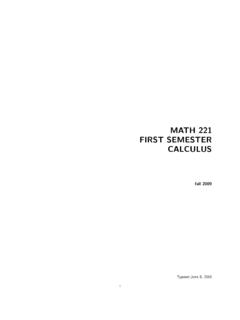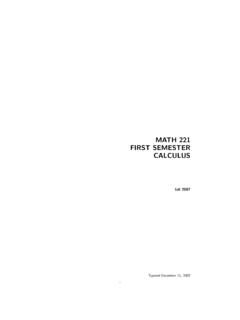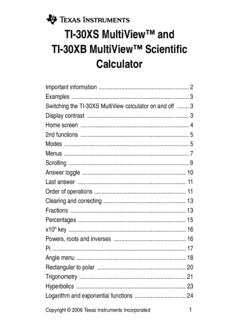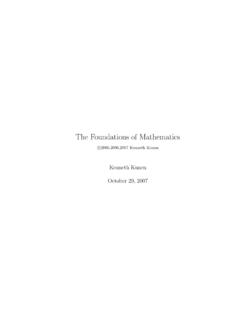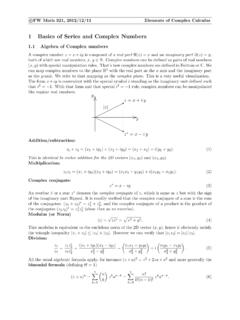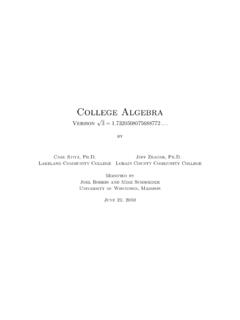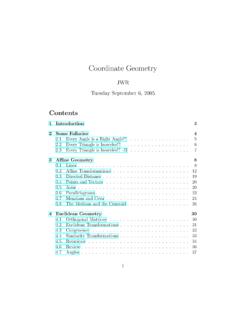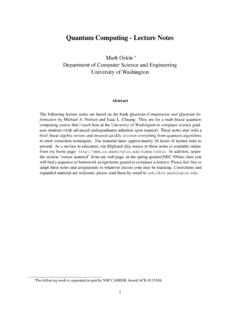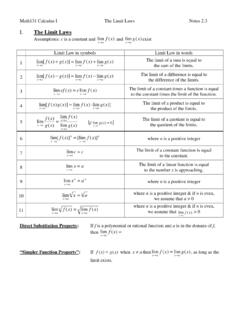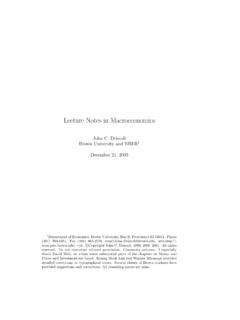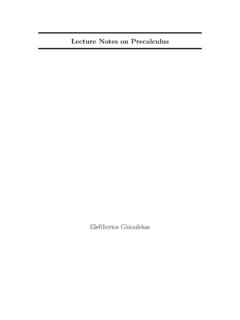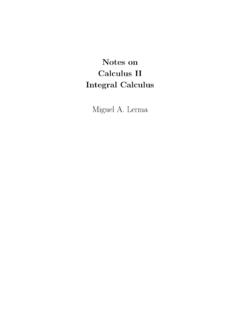Transcription of Complex Numbers and the Complex Exponential
1 Complex Numbers and the Complex Exponential1. Complex numbersThe equationx2+ 1 = 0 has no solutions, because for any real numberxthe squarex2is nonnegative, and sox2+ 1 can never be less than 1. In spite of this it turns out tobe very useful toassumethat there is a numberifor which one has(1)i2= numberis then an expression of the forma+bi, whereaandbare old-fashioned real Numbers . The numberais called thereal partofa+bi, andbis called itsimaginary the letterszandware used to stand for Complex any Complex number is specified by two real Numbers one can visualize themby plotting a point with coordinates (a,b) in the plane for a Complex numbera+bi. Theplane in which one plot these Complex Numbers is called the Complex plane, or +bia=Re(z)b=Im(z) = argzr=|z|= a2+b2 Figure Complex can add, multiply and divide Complex Numbers . Here s how:To add (subtract)z=a+biandw=c+diz+w= (a+bi) + (c+di) = (a+c) + (b+d)i,z w= (a+bi) (c+di) = (a c) + (b d) multiplyzandwproceed as follows:zw= (a+bi)(c+di)=a(c+di) +bi(c+di)=ac+adi+bci+bdi2= (ac bd) + (ad+bc)iwhere we have use the defining propertyi2= 1 to get rid divide two Complex Numbers one always uses the following +bic+di=a+bic+di c dic di=(a+bi)(c di)(c+di)(c di)Now(c+di)(c di) =c2 (di)2=c2 d2i2=c2+d2,soa+bic+di=(ac+bd) + (bc ad)ic2+d2=ac+bdc2+d2+bc adc2+d2iObviously you do not want to memorize this formula: instead you remember the trick, to dividec+diintoa+biyou multiply numerator and denominator withc any Complex numberw=c+dithe numberc diis called itscomplex :w=c+di, w=c frequently used property of the Complex conjugate is the following formula(2)w w= (c+di)(c di) =c2 (di)2=c2+ following notation is used for thereal and imaginary partsof a Complex numberz.
2 Ifz=a+bithena= the Real Part ofz=Re(z), b= the Imaginary Part ofz=Im(z).Note that bothRezandImzare real Numbers . A common mistake is to say thatImz= i shouldnotbe Argument and Absolute ValueFor any given Complex numberz=a+bione defines theabsolute valueormodulusto be|z|= a2+b2,so|z|is the distance from the origin to the pointzin the Complex plane (see figure1).The angle is called theargumentof the Complex numberz. Notation:argz= .The argument is defined in an ambiguous way: it is only defined up to a multiple of2 . the argument of 1 could be , or , or 3 , or, etc. In general one saysarg( 1) = + 2k , wherekmay be any trigonometry one sees that for any Complex numberz=a+bione hasa=|z|cos ,andb=|z|sin ,so that|z|=|z|cos +i|z|sin =|z|(cos +isin ).3andtan =sin cos = Example: Find argument and absolute value ofz= 2 + :|z|= 22+ 12= in the first quadrant so its argument is an angle between 0and /2.
3 From tan =12we then conclude arg(2 +i) = = Geometry of ArithmeticSince we can picture Complex Numbers as points in the complexplane, we can alsotry to visualize the arithmetic operations addition and multiplication. To addzandabcdzwz+wFigure ofz=a+biandw=c+diwone forms the parallelogram with the origin,zandwas vertices. The fourth vertexthen isz+w. See +biiz= b+aiFigure ofa+ understand multiplication we first look at multiplication withi. Ifz=a+bitheniz=i(a+bi) =ia+bi2=ai b= b+ , to formizfrom the Complex numberzone rotateszcounterclockwise by 90 any real number, then multiplication ofw=c+dibyagivesaw=ac+adi,4 2z zz2z3zFigure of a real and a Complex numbersoawpoints in the same direction, but isatimes as far away from the origin. Ifa <0thenawpoints in the opposite direction. See , to multiplyz=a+biandw=c+diwe write the product aszw= (a+bi)w=aw+ +bion the right. On the left, the Complex numberwwas first drawn,iwwawaw+biwaa+bibiw bFigure of two Complex numbersthenawwas drawn.
4 Subsequentlyiwandbiwwere constructed, and finallyzw=aw+biwwas drawn by sees from figure5that sinceiwis perpendicular tow, the line segment from 0tobiwis perpendicular to the segment from 0 toaw. Therefore the larger shaded triangleon the left is a right triangle. The length of the adjacent side isa|w|, and the length ofthe opposite side isb|w|. The ratio of these two lengths isa:b, which is the same as forthe shaded right triangle on the right, so we conclude that these two triangles are triangle on the left is|w|times as large as the triangle on the right. The twoangles marked are |zw|is the length of the hypothenuse of the shaded triangle on theleft, it is|w|times the hypothenuse of the triangle on the right, |zw|=|w| |z|.5 The argument ofzwis the angle + ; since = argzand = argwwe get thefollowing two formulas|zw|=|z| |w|(3)arg(zw) = argz+ argw,(4)in other words,when you multiply Complex Numbers , their lengths get multipliedand their arguments get Applications in Unit length Complex any the numberz= cos +isin haslength 1: it lies on the unit circle.
5 Its argument is argz= . Conversely, any complexnumber on the unit circle is of the form cos +isin , where is its The Addition Formulas for Sine & any two angles and onecan multiplyz= cos +isin andw= cos +isin . The productzwis a Complex numberof absolute value|zw|=|z| |w|= 1 1, and with argument arg(zw) = argz+argw= + .Sozwlies on the unit circle and must be cos( + ) +isin( + ). Thus we have(5)(cos +isin )(cos +isin ) = cos( + ) +isin( + ).By multiplying out the Left Hand Side we get(cos +isin )(cos +isin ) = cos cos sin sin (6)+i(sin cos + cos sin ).Compare the Right Hand Sides of (5) and (6), and you get the addition formulas for Sineand Cosine:cos( + ) = cos cos sin sin sin( + ) = sin cos + cos sin De Moivre s any Complex numberzthe argument of its squarez2is arg(z2) = arg(z z) = argz+ argz= 2 argz. The argument of its cube is argz3=arg(z z2) = arg(z) + argz2= argz+ 2 argz= 3 argz. Continuing like this one finds that(7)argzn=nargzfor any this toz= cos +isin you find thatznis a number with absolute value|zn|=|z|n= 1n= 1, and argumentnargz=n.
6 Hencezn= cosn +isinn . So wehave found(8)(cos +isin )n= cosn +isinn .This isde Moivre s instance, forn= 2 this tells us thatcos 2 +isin 2 = (cos +isin )2= cos2 sin2 + 2icos sin .Comparing real and imaginary parts on left and right hand sides this gives you the doubleangle formulas cos = cos2 sin2 and sin 2 = 2 sin cos .Forn= 3 you get, using theBinomial Theorem,or Pascal s triangle,(cos +isin )3= cos3 + 3icos2 sin + 3i2cos sin2 +i3sin3 = cos3 3 cos sin2 +i(3 cos2 sin sin3 )6so thatcos 3 = cos3 3 cos sin2 andsin 3 = cos2 sin sin3 .In this way it is fairly easy to write down similar formulas for sin 4 , sin 5 , ..5. calculus of Complex valued functionsAcomplex valued functionon some intervalI= (a,b) Ris a functionf:I a function can be written as in terms of its real and imaginary parts,(9)f(x) =u(x) +iv(x),in whichu,v:I Rare two real valued defines limits of Complex valued functions in terms of limits of their real andimaginary parts.
7 Thus we say thatlimx x0f(x) =Liff(x) =u(x) +iv(x),L=A+iB, and bothlimx x0u(x) =Aand limx x1v(x) =Bhold. From this definition one can prove that the usual limit theorems also apply tocomplex valued x0f(x) =Landlimx x0g(x) =M, then one haslimx x0f(x) g(x) =L M,limx x0f(x)g(x) =LM,limx x0f(x)g(x)=LM,providedM6= a Complex valued functionf(x) =u(x)+iv(x) is defined by simplydifferentiating its real and imaginary parts:(10)f (x) =u (x) +iv (x).Again, one finds that the sum,product and quotient rules alsohold for Complex ,g:I Care Complex valued functions which are differentiableat somex0 I, then the functionsf g,fgandf/gare differentiable (assumingg(x0)6= 0in the case of the quotient.) One has(f g) (x0) =f (x0) g (x0)(fg) (x0) =f (x0)g(x0) +f(x0)g (x0)(fg) (x0) =f (x0)g(x0) f(x0)g (x0)g(x0)2 Note that the chain rule does not appear in this list! See problem29for more about thechain The Complex Exponential FunctionWe finally give a definition ofea+bi.
8 First we consider the casea= 0:71ei = cos +isin Figure s definition ofei any real numbertwe seteit= cost+ i= cos +isin = 1. This leads to Euler s famous formulae i+ 1 = 0,which combines the five most basic quantities in mathematics:e, ,i, 1, and why the a good haven t definedeitbefore and we can do anything we the Taylor series forex:eit= 1 +it+(it)22!+(it)33!+(it)44!+ = 1 +it t22! it33!+t44!+it55! = 1 t2/2! +t4/4! +i(t t3/3! +t5/5! )= cost+ is not a proof, because before we had only proved the convergence of the Taylor seriesforexifxwas a real number, and here we have pretended that the series is also good ifyou substitutex= a function oftthe us the correct , using the chain rule ( pretending it still applies for Complex functions) wewould getdeitdt= , this is correct. To see this proceed from our :deitdt=dcost+isintdt=dcostdt+idsintdt= sint+icost=i(cost+isint)8 Reason formulaex ey=ex+ystill holds.
9 Rather, we haveeit+is= check this replace the exponentials by their definition:eiteis= (cost+isint)(coss+isins) = cos(t+s) +isin(t+s) =ei(t+s).Requiringex ey=ex+yto be true for all Complex Numbers helps us decide whatea+bishoud be for arbitrary Complex numbersa+ any Complex numbera+biwe setea+bi=ea eib=ea(cosb+isinb).One verifies as above in reason 3 that this gives us the rightbehaviour under differen-tiation. Thus, for any Complex numberr=a+bithe functiony(t) =ert=eat(cosbt+isinbt)satisfiesy (t) =dertdt= Complex solutions of polynomial Quadratic well-known quadratic formula tells you that theequation(11)ax2+bx+c= 0has two solutions, given by(12)x = b D2a, D=b2 the coefficientsa,b,care real Numbers and if thediscriminantDis positive, then thisformula does indeed give two real solutionsx+andx . However, ifD <0, then there areno real solutions, but there are two Complex solutions, namelyx = b2a i Example: solvex2+ 2x+ 5 = :Use the quadratic formula, orcomplete the square:x2+ 2x+ 5 = 0 x2+ 2x+ 1 = 4 (x+ 1)2= 4 x+ 1 = 2i x= 1 , if you allow Complex solutions then every quadratic equation has two solutions,unless the two solutions coincide (the caseD= 0, in which there is only one solution.)
10 9112+i2 3 12+i2 3 1 12 i2 312 i2 3 Figure 7. The sixth roots of are six of them, and they re arranged in aregular Complex roots of a any given Complex numberwthere is amethod of finding all Complex solutions of the equation(13)zn=wifn= 2,3,4, is a given find these solutions you writewin polar form, you findr >0 and such thatw=rei . Thenz=r1/nei /nis a solution to (13). But it isn t the only solution, because the angle for whichw=ri isn t unique it is only determined up to a multiple of 2 . Thus if we have found oneangle for whichw=ri , then we can also writew=rei( +2k ), k= 0, 1, 2, Thenthroots ofware thenzk=r1/nei( n+2kn )Herekcan be any integer, so it looks as if there are infinitely many solutions. However,if you increasekbyn, then the exponent above increases by 2 i, and hencezkdoes notchange. In a formula:zn=z0, zn+1=z1, zn+2=z2, .. zk+n=zkSo if you takek= 0,1,2, ,n 1 then you have had all the solutionszkalways form a regular polygon Example: find all sixth roots ofw= are to solvez6= 1.
